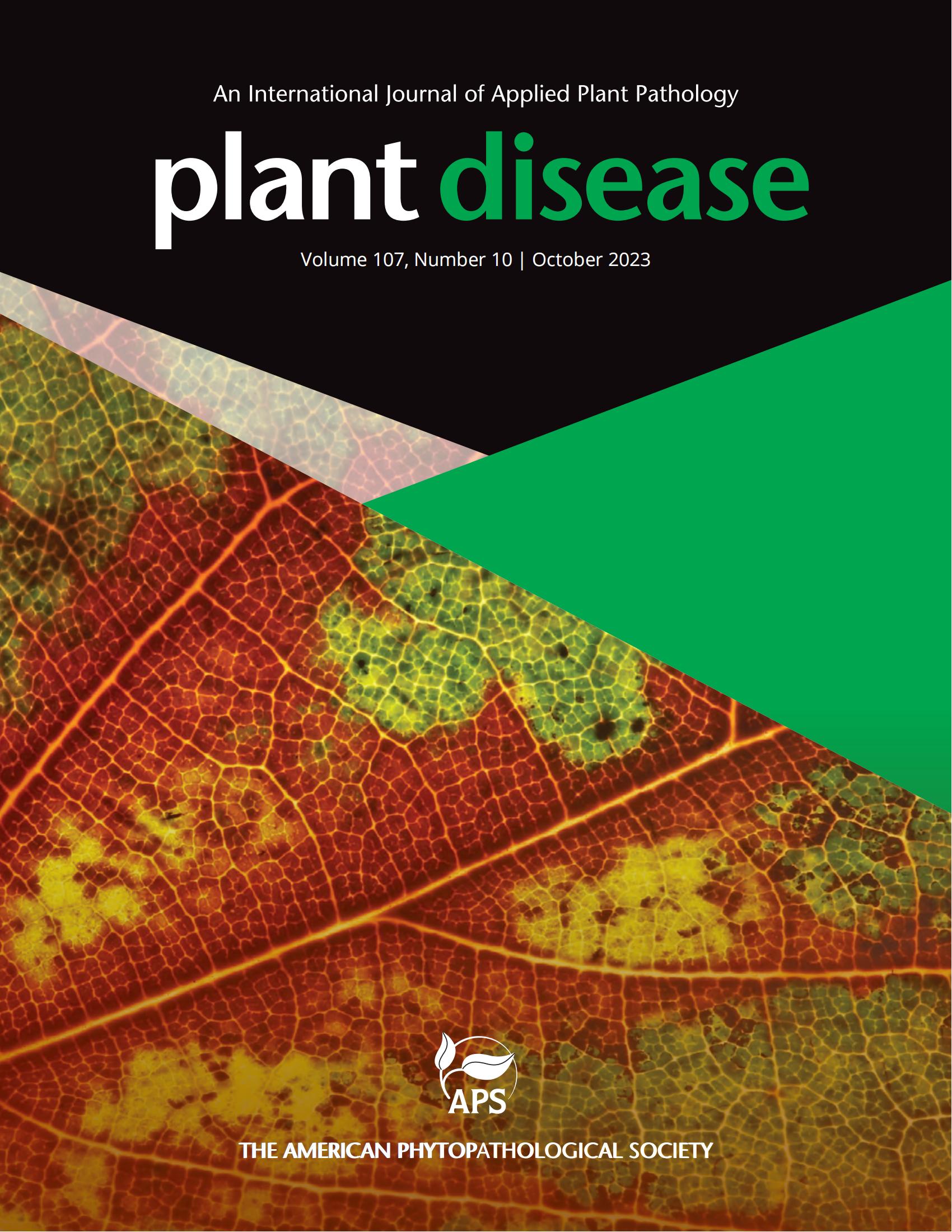科罗拉多州首次报告由红疫病菌(Phytophthora erythroseptica)引起的马铃薯粉红腐烂病。
摘要
由卵菌 Phytophthora erythroseptica 引起的粉腐病是一种严重的病害,可能会给马铃薯种植者造成巨大损失。2023 年,科罗拉多州圣路易斯谷(SLV)在收获前后和储藏过程中发现粉腐病感染率很高,一些种植者因粉腐病损失了整个储藏销。2023 年 9 月,在收获季节,从圣路易斯谷研究中心附近的两个种植者的罗塞特-诺科塔(约 2-3%感染率)和卡内拉罗塞特(约 5%感染率)种植田中采集到了出现粉红腐烂症状的块茎。受感染的块茎茎端表面出现深色变色。切开后,大约 20-30 分钟后,受影响的组织呈现鲑鱼粉红色(图 1)。按照生产商的说明,使用 DNeasy PowerSoil Pro 试剂盒(Qiagen,美国马里兰州)从每个栽培品种的两个有症状块茎和健康块茎中提取 DNA。采用 Cullen 等人(2007 年)开发的传统 PCR 和 qPCR 检测方法检测赤霉病菌。在常规 PCR 检测中,引物对 Pery2F1/R1 在有症状的块茎上产生 135bp 的预期条带,而在健康块茎上则没有。在使用 99F、177R 和 133T 引物探针组进行的 qPCR 中,有症状的块茎呈阳性(Cullen 等人,2007 年)。通过在 PARP 选择性培养基(Jeffers 和 Martin,1986 年)上培养受感染组织的标本,分离出赤霉病菌。一周后,培养基上长出了白色的菌落。如上所述,这些菌落通过聚合酶链式反应(PCR)被确认为赤霉病菌。将两株分离菌的菌落转移到水琼脂培养基上,三天后切除菌丝顶端,在 PDA 培养基上进行单株分离培养。在 PDA 培养基上,菌落呈现菊花图案。四天后,从 RN296-1 和 Canela-2 这两个分离物中提取了 DNA,并通过上述 PCR 方法检测出对赤霉病菌呈阳性。用两种分离物的 PDA 琼脂塞接种表面消毒过的马铃薯块茎。将分离株 SLV-2023-Canela2 接种到 Russet Norkotah 和 Reveille Russet 的块茎上,各 10 块,而将分离株 SLV-2023-RN296-1 接种到 Russet Norkotah 的 10 块块茎上。将 10 个 Russet Norkotah 块茎接种到已消毒的 PDA 插头上,作为阴性对照。块茎在室温下放置一周。所有接种了 SLV-2023-Canela2 和 RN296-4 的 Russet Norkotah 块茎都出现了粉红腐烂症状,PCR 检测对赤霉病菌呈阳性,而只有 9 个接种了 SLV-2023-Canela2 的 Reveille Russet 块茎出现了症状,PCR 检测对赤霉病菌呈阳性。在模拟接种的块茎上没有观察到任何症状,通过 PCR 也没有检测到赤霉病菌。在 PDA 培养基上接种 RN296-1 的 Russet Norkotah 块茎上再次分离出赤霉病菌,一周后通过 PCR 检测赤霉病菌呈阳性。为了进一步确认身份,使用引物 ITS-1 和 ITS-4(White 等人,1990 年)从接种了 SLV-2023-Canela2 分离物的 Russet Norkotah 块茎中提取的 DNA 中扩增了 ITS 区域。PCR 产物用 QIAquick Gel Extraction Kit(Qiagen,美国马里兰州)纯化,并用 TOPO TA Cloning Kit for Sequencing(Invitrogen,美国马里兰州)进行克隆。四个克隆被提交测序。ITS 的 846 nt 序列已提交至 GenBank(登录号 PP587391),与 P. erythroseptica 菌株 BBA 62683(KJ755119)有 99.76% 的相同性。以前曾利用形态学工具从在 SLV 收集到的症状类似粉红腐烂病的块茎中鉴定出 P. erythroseptica(Tyler 等人,2002 年)。因此,本研究是科罗拉多州 SLV 地区粉红腐烂病的首次分子鉴定报告。快速变化的气候和收获期气温的升高可能会导致粉腐病发病率的增加,因此需要制定和实施有效的管理策略。Pink rot, caused by the oomycete Phytophthora erythroseptica, is a serious disease that may cause substantial losses to potato growers. In 2023, high infection rates of pink rot were noticed in the San Luis Valley (SLV), Colorado around harvest time and in storage with several growers losing complete storage pins to pink rot. In September 2023, tubers with pink rot symptoms were collected from two grower fields of Russet Norkotah (~2-3% infection) and Canela Russet (~5% infection) near the San Luis Valley Research Center at harvest time. Infected tubers showed dark discoloration on the surface at the stem end. Upon cutting, affected tissue developed salmon pink color about 20-30 min later (Fig. 1). DNA was extracted from two symptomatic tubers from each cultivar and healthy tubers using DNeasy PowerSoil Pro Kit (Qiagen, MD, USA) according to the manufacturer's instructions. The conventional PCR and qPCR assays developed by Cullen et al. (2007) were used to detect P. erythroseptica. In the conventional PCR, the primer pair Pery2F1/R1 produced expected bands of 135bp from symptomatic tubers but not from the healthy tubers. The symptomatic tubers were positive in the qPCR using the primer-probe set 99F, 177R, and 133T (Cullen et al., 2007). P. erythroseptica was isolated by culturing specimens of infected tissues on PARP selective media (Jeffers and Martin, 1986). A week later colonies of white color grew on the media. These colonies were confirmed to be of P. erythroseptica by PCR as mentioned above. The colonies of two isolates were transferred to water agar media, then three days later a mycelium tip was excised and cultured on PDA media for single isolation. On PDA media the colonies showed chrysanthemum pattern. Four days later DNA was extracted from the two isolates, RN296-1 and Canela-2, and tested positive for P. erythroseptica by the above-mentioned PCR. PDA agar plugs of two isolates were used to inoculate surface sterilized potato tubers. The isolate SLV-2023-Canela2 was inoculated on tubers of Russet Norkotah and Reveille Russet, 10 each, while10 tubers of Russet Norkotah were inoculated with the isolate SLV-2023-RN296-1. Ten tubers of Russet Norkotah were inoculated by sterilized plugs of PDA for negative controls. Tubers were left at room temperature for a week. All tubers of Russet Norkotah inoculated with SLV-2023-Canela2 and RN296-4 developed pink rot symptoms and tested positive for P. erythroseptica by PCR, while only 9 tubers of Reveille Russet inoculated with SLV-2023-Canela2 developed symptoms and were positive to P. erythroseptica by PCR. No symptoms were observed on the mock inoculated tubers and no P. erythroseptica was detected by the PCR. P. erythroseptica was isolated again from Russet Norkotah tubers inoculated with RN296-1 on PDA media and tested positive for P. erythroseptica by PCR one week later. To further confirm the identity, the ITS region was amplified using the primers ITS-1 and ITS-4 (White et al., 1990) from DNA extracted from inoculated Russet Norkotah tubers with SLV-2023-Canela2 isolate. PCR product was purified using QIAquick Gel Extraction Kit (Qiagen, MD, USA)and cloned using TOPO TA Cloning Kit for Sequencing (Invitrogen, MD, USA). Four clones were submitted for sequencing. The 846 nt sequence of the ITS was submitted to the GenBank (accession number PP587391) shared 99.76% identity with the P. erythroseptica strain BBA 62683 (KJ755119). P. erythroseptica was identified previously using morphological tools from tubers with symptoms resembling pink rot collected in the SLV (Tyler et al., 2002). However, in that report neither Koch's Postulates, nor molecular identification were conducted, hence, the current study presents the first molecular report of pink rot in the SLV, Colorado. Rapidly changing climate and increased temperature around harvest time may lead to an increase in the incidence of pink rot, hence effective management strategies need to be developed and implemented.

 求助内容:
求助内容: 应助结果提醒方式:
应助结果提醒方式:


